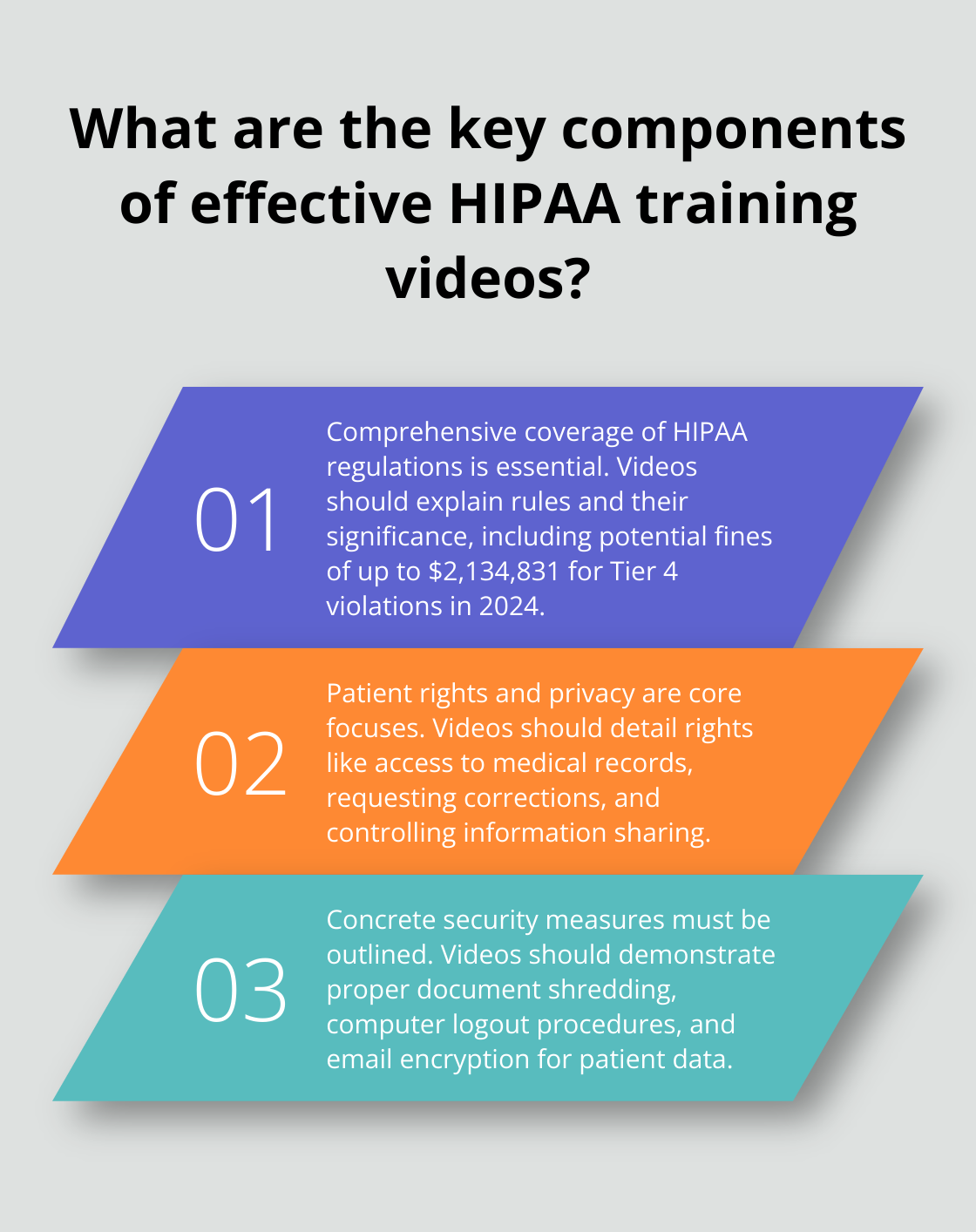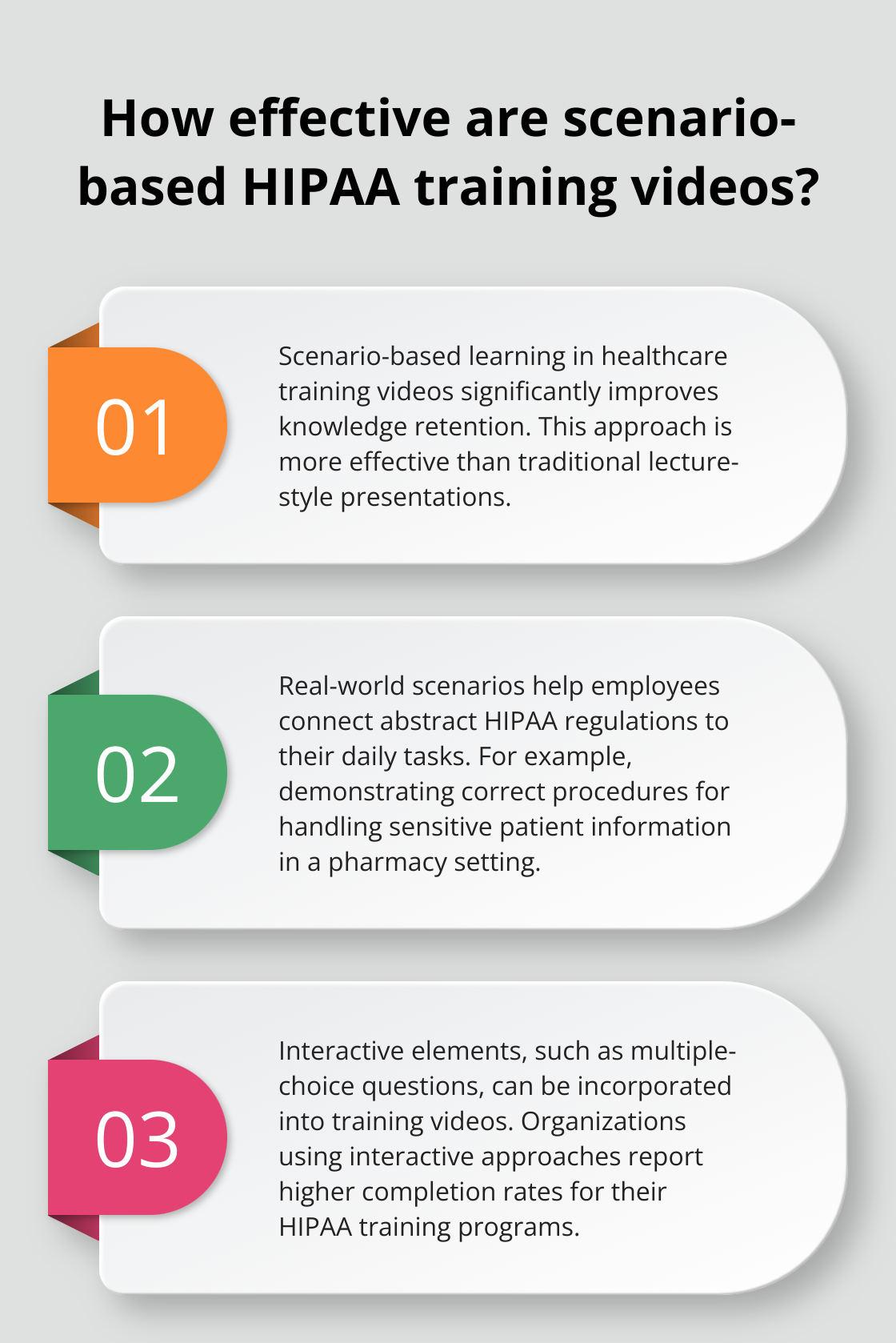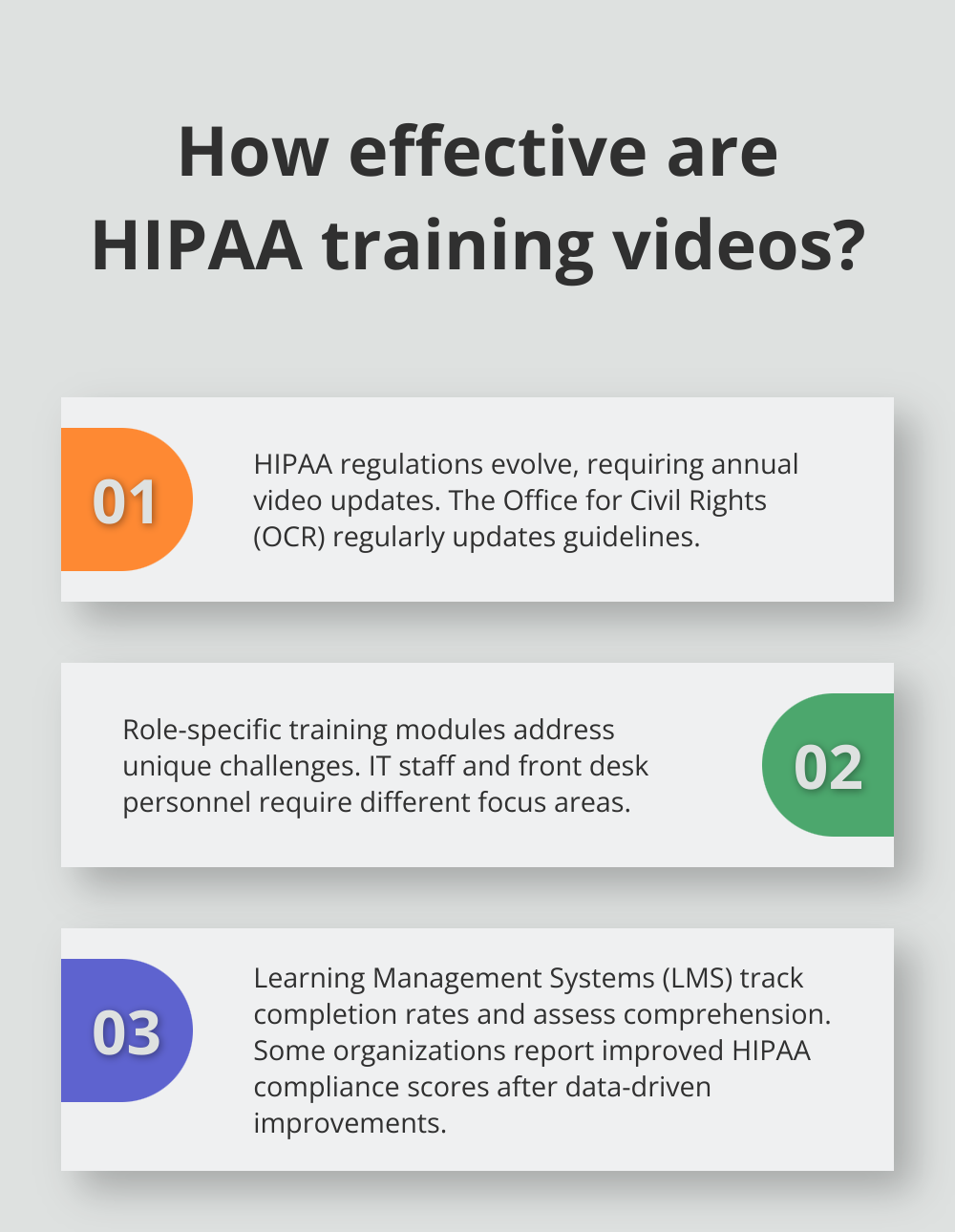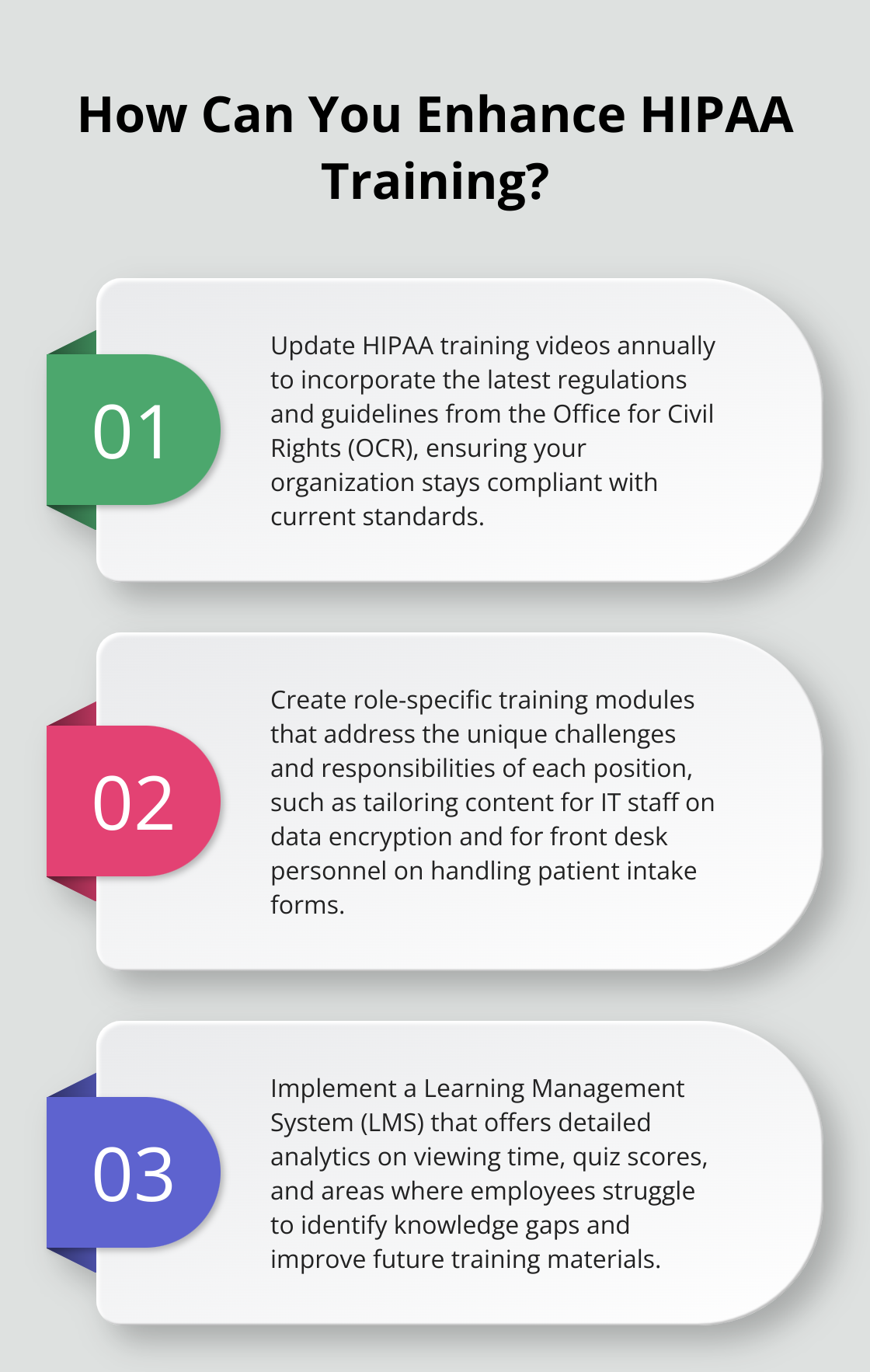HIPAA compliance training videos are essential for healthcare organizations to protect patient privacy and maintain regulatory standards. These videos offer an engaging and effective way to educate staff on complex regulations.
At ScriberJoy, we understand the importance of creating impactful HIPAA compliance training videos that resonate with healthcare professionals. In this post, we’ll explore the key components, production techniques, and best practices for developing training materials that ensure your team stays compliant and informed.
What Makes HIPAA Training Videos Effective?
HIPAA compliance training videos serve as a powerful tool for healthcare organizations. Their effectiveness depends on specific components that we have identified as key elements for creating impactful educational materials.
Comprehensive Coverage of HIPAA Regulations
An effective HIPAA training video must provide a thorough overview of the regulations. It should explain not only the rules but also their significance. For example, highlighting the potential fines for HIPAA violations (up to $2,134,831 in 2024 for the most serious Tier 4 violations) emphasizes the importance of compliance.
Focus on Patient Rights and Privacy
Patient rights form the core of HIPAA. Training videos should detail these rights, including:
- Access to medical records
- Requesting corrections
- Controlling information sharing
A practical approach involves the inclusion of scenarios that demonstrate how to handle patient requests for their records or respond to requests for restricted information sharing.
Concrete Security Measures
Security in healthcare requires specific actions. Videos should outline clear steps to protect health information, such as:
- Using strong passwords
- Encrypting emails with patient data
- Properly disposing of physical documents
Demonstrating the correct way to shred documents or log out of computer systems can significantly reduce the risk of data breaches.
Handling Protected Health Information
The proper management of Protected Health Information (PHI) plays a critical role in HIPAA compliance. Videos should illustrate the dos and don’ts of PHI handling. This could include examples of secure ways to discuss patient information in various settings (e.g., using privacy screens on computers in open areas or speaking quietly about patients in semi-private spaces).
Interactive Elements and Assessments
To enhance engagement and retention, effective HIPAA training videos should incorporate interactive elements. These may include:
- Quizzes to test knowledge retention
- Scenario-based questions to apply learned concepts
- Clickable hotspots to explore different aspects of HIPAA compliance

The addition of these interactive components transforms passive viewing into active learning, increasing the overall effectiveness of the training.
As we move forward, we’ll explore the engaging video production techniques that can elevate your HIPAA training materials from informative to truly captivating.
When implementing HIPAA compliance training, it’s crucial to choose the right HIPAA compliance software vendors for your business by evaluating features, pricing, and reviews for optimal data security and compliance.
How to Create Engaging HIPAA Training Videos
Creating engaging HIPAA training videos is essential for effective compliance education. Combining compelling content with innovative production techniques significantly improves knowledge retention and application.
Bring HIPAA to Life with Real-World Scenarios
One of the most effective ways to engage viewers is through real-world scenarios. Instead of simply listing HIPAA rules, show how they apply in everyday situations. For example, create a scene where a pharmacy employee places a customer’s insurance card in another customer’s prescription bag. Then, demonstrate the correct procedure for handling sensitive patient information.

These scenarios help employees connect abstract regulations to their daily tasks. A study by the Journal of Medical Internet Research found that scenario-based learning in healthcare training videos can significantly improve knowledge retention compared to traditional lecture-style presentations.
Make It Interactive
Static videos often fail to capture and maintain attention. To combat this, incorporate interactive elements throughout your training videos. Pause the video at key moments and present multiple-choice questions about the content just covered. This not only keeps viewers engaged but also reinforces learning.
Tools like H5P allow you to add interactive quizzes directly into your videos. Organizations using this approach report higher completion rates for their HIPAA training programs.
Simplify Complex Concepts
HIPAA regulations can be intricate and overwhelming. Your job is to break them down into digestible pieces. Use analogies and visual aids to explain complex ideas. For instance, when discussing the concept of PHI, you might compare it to a locked safe that only authorized personnel can access.
Infographics and animated explainers can be particularly effective. Healthcare organizations have reported that implementing animated explainers in their HIPAA training videos can increase employee understanding of key concepts.
Invest in Professional Production
While it might be tempting to cut corners, investing in professional-quality production pays off. High-quality narration ensures that your message is clear and easy to follow. Professional voice actors can inject energy and emphasis where needed, keeping viewers engaged throughout the training.
Visual quality matters too. Clean, well-designed graphics and animations can make complex information more accessible and memorable. Studies have shown that videos with high production value can significantly increase viewer engagement compared to low-quality alternatives.
The techniques discussed in this chapter will help you create HIPAA training videos that not only inform but also engage and inspire your team to maintain the highest standards of patient privacy and data security. In the next section, we’ll explore best practices for implementing these training videos effectively within your organization.
By following these guidelines, small businesses can ensure HIPAA compliance and protect patient data while avoiding costly fines.
How to Implement HIPAA Training Videos Effectively
Keep Content Fresh and Relevant
HIPAA regulations evolve, and your training videos must evolve with them. The Office for Civil Rights (OCR) regularly updates guidelines. Failure to incorporate these changes can lead to compliance gaps. Review and update your training videos at least annually. In 2024, the OCR combined HIPAA updates with guidance to explain how HIPAA applies in certain situations. Healthcare organizations that promptly updated their training materials were better equipped to handle these new aspects of compliance.
Tailor Training to Specific Roles
Generic training rarely proves effective. A receptionist and a nurse practitioner interact differently with protected health information (PHI), and their training should reflect this. Create role-specific modules that address the unique challenges and responsibilities of each position. IT staff might need in-depth training on data encryption and secure network practices. Front desk personnel might focus more on proper handling of patient intake forms and verbal communication protocols.
Track and Measure Training Effectiveness
A robust Learning Management System (LMS) is essential for tracking completion rates and assessing comprehension. Select an LMS that offers detailed analytics on viewing time, quiz scores, and areas where employees struggle. This data helps identify knowledge gaps and improve future training materials. Some healthcare organizations have reported improvements in HIPAA compliance scores after implementing data-driven improvements to their training programs.
Supplement Videos with Additional Resources
Videos serve as an excellent primary training tool, but they shouldn’t stand alone. Create a comprehensive training ecosystem by supplementing videos with:
- Quick reference guides for common HIPAA scenarios
- Interactive online modules for practicing decision-making
- Regular email updates on HIPAA news and best practices
- In-person workshops for complex topics or role-playing exercises

A multi-faceted approach reinforces learning and caters to different learning styles.
Leverage Technology for Accessibility
Modern technology offers numerous ways to make HIPAA training videos more accessible and engaging. Consider implementing mobile-friendly versions of your training videos, allowing staff to access them on their smartphones or tablets. This flexibility can increase completion rates, especially for healthcare professionals with busy schedules. Additionally, try to incorporate closed captions and transcripts for your videos. These features not only improve accessibility for staff with hearing impairments but also cater to different learning preferences.
To ensure comprehensive HIPAA compliance, it’s crucial to choose the right HIPAA compliance software that can support your training initiatives and overall data security efforts. Additionally, the rise of remote HIPAA compliance jobs has created new opportunities and challenges in implementing effective training programs across distributed teams.
Final Thoughts
HIPAA compliance training videos empower healthcare organizations to protect patient privacy and adhere to critical regulations. These videos create a strong foundation for a compliance culture by covering HIPAA rules, patient rights, and security measures. Real-world scenarios, interactive elements, and professional production techniques enhance the training experience and improve its effectiveness.

Healthcare organizations must update their HIPAA compliance training videos regularly to maintain relevance and measure effectiveness. Role-specific content and robust tracking mechanisms play a vital role in this process. Supplementing videos with additional resources reinforces key concepts and caters to various learning styles, creating a comprehensive training program.
Quality HIPAA compliance training videos mitigate risks, build patient trust, and foster staff responsibility. We recommend using ScribeJoy to streamline your documentation processes while maintaining HIPAA compliance. With the right training approach and proper tools, healthcare organizations can confidently navigate HIPAA regulations and ensure the protection of sensitive patient information.

Leave a Reply
You must be logged in to post a comment.